JOURNAL OF EDUCATIONAL AND BEHAVIORAL STATISTICS OnlineFirst, published on August 10, 2015 as
doi:10.3102/1076998615595403
Journal of Educational and Behavioral Statistics
Vol. XX, No. X, pp. 1–23
DOI: 10.3102/1076998615595403
# 2015 AERA. http://jebs.aera.net
Bayesian Estimation of the DINA Model
With Gibbs Sampling
Steven Andrew Culpepper
University of Illinois at Urbana-Champaign
A Bayesian model formulation of the deterministic inputs, noisy ‘‘and’’ gate
(DINA) model is presented. Gibbs sampling is employed to simulate from the
joint posterior distribution of item guessing and slipping parameters, subject
attribute parameters, and latent class probabilities. The procedure extends
concepts in Be´guin and Glas, Culpepper, and Sahu for estimating the guessing
and slipping parameters in the three- and four-parameter normal-ogive models.
The ability of the model to recover parameters is demonstrated in a simulation
study. The technique is applied to a mental rotation test. The algorithm and
vignettes are freely available to researchers as the ‘‘dina’’ R package.
Keywords: cognitive diagnosis; bayesian statistics; markov chain monte carlo; spatial
cognition
Introduction
Cognitive diagnosis models (CDMs) remain an important methodology for
diagnosing student skill acquisition. A variety of CDMs have been developed.
In particular, existing CDMs include the deterministic inputs, noisy ‘‘and’’ gate
(DINA) model (de la Torre, 2009a; de la Torre & Douglas, 2004, 2008; Doignon
& Falmagne, 1999; Haertel, 1989; Junker & Sijtsma, 2001; Macready & Dayton,
1977), the noisy inputs, deterministic, ‘‘and’’ gate (NIDA) model (Maris, 1999),
the deterministic input, noisy ‘‘or’’ gate (DINO) model (Templin & Henson,
2006b), the reduced reparameterized unified model (RUM; Roussos, DiBello,
et al., 2007), the generalized DINA (de la Torre, 2011), the log-linear CDM
(Henson, Templin, & Willse, 2009), and the general diagnostic model (von
Davier, 2008). The aforementioned models differ in complexity, and prior research
demonstrated how models such as the DINA, NIDA, and DINO can be estimated
in more generalized frameworks (e.g., see de la Torre, 2011; von Davier, 2014).
The interpretability of the DINA model makes it a popular CDM (de la Torre,
2009a; von Davier, 2014), and the purpose of this article is to introduce a Bayesian
formulation for estimating the DINA model parameters with Gibbs sampling.
This article includes five sections. The first section introduces the DINA
model and discusses benefits of the proposed Bayesian formulation in the context
1
Downloaded from
http://jebs.aera.net
at CMU Libraries - library.cmich.edu on December 8, 2015
�
Bayesian Estimation of the DINA
of prior research. The second section presents the Bayesian model formulation
and full conditional distributions that are used to estimate person (i.e., latent
skill/attribute profiles) and item parameters (i.e., slipping and guessing) using
Markov Chain Monte Carlo (MCMC) with Gibbs sampling. The third section
reports results from a simulation study on the accuracy of recovering the model
parameters. The fourth section presents an application of the model using
responses to a mental rotation test (Guay, 1976; Yoon, 2011). The final section
includes discussion, future research directions, and concluding remarks.
The DINA Model
Overview
Throughout this article, let i ¼ 1; . . . ; N index individuals, j ¼ 1; . . . ; J
index items, k ¼ 1; . . . ; K index skills, and c ¼ 1; . . . ; C index latent classes.
CDMs assume that a set of K known skills underlie each item. The skills needed
to succeed on each item are collected into a J � K matrix Q, which is a structure
matrix with elements that are akin to factor loadings relating skills to items. How-
ever, one exception is that the elements of Q are either 0 or 1 (i.e., qjk 2 f0; 1g)
depending upon whether skill k is needed for success on item j. That is, qjk equals
1 if skill k is needed to correctly answer item j and 0 otherwise. Let
j ¼ ðqj1; . . . ; qjKÞ be the j th row of Q ¼ ðq1; . . . ; qJÞ0
, which indicates the
0
q
requisite skills for item j.
The DINA model posits that individual test takers are classified into latent
classes based upon mastery and nonmastery of the K skills. Let aik equal 1 if
individual i has mastered skill k and zero otherwise. Furthermore, let the K
dimensional latent attribute profile of binary indicators for individual i be
αi ¼ ðai1; :::; aiKÞ0
. Given the categorical nature of the latent classes, αi can equal
one of C¼ 2K attribute profiles. It will be useful subsequently to define
αc ¼ ðac1; . . . ; acKÞ0
as the attribute profile for members of class c such that
ack is 1 if members of class c possess skill k and zero otherwise.
The DINA model is a conjunctive model, which implies that students need
to correctly answer item j without guessing. We
all of the skills in qj
let the vector of ideal responses for student i be η
jqjÞ, where I denotes the indicator function.
Zij ¼ ∏K
Notice that Zij is 1 if student i has the requisite skills to answer item j and 0 if
the student is missing at least one skill. The probability of individual i’s success
on item j for the DINA model is a function of individual latent class membership
(i.e., αi) and item parameters,
i ¼ ðZi1; . . . ; ZiJÞ0
ik ¼ Iðα0
iqj ¼ q
with
k¼1aqjk
0
(
Pðyij ¼ 1jαi; ΩjÞ ¼
2
gj; Zij ¼ ∏K
1 � sj; Zij ¼ ∏K
k¼1aqjk
k¼1aqjk
ik ¼ 0
ik ¼ 1
;
(1)
Downloaded from
http://jebs.aera.net
at CMU Libraries - library.cmich.edu on December 8, 2015
�
Culpepper
where Ωj ¼ ðgj; sjÞ is a row vector of
gj ¼ Pðyij ¼ 1jZij ¼ 0Þ is the probability of correctly guessing item j for students
sj ¼ Pðyij ¼ 0jZij ¼ 1Þ is the probability of ‘‘slipping,’’ which is defined as the
who do not have the requisite skills needed for
item parameters. By definition,
In contrast,
item j.
chance that students who have the required skills to answer item j record an
incorrect response.
The DINA item response function can be used to construct a likelihood of
observing a sample of item responses. Let yi ¼ ðyi1; . . . ; yiJÞ0
denote a J dimen-
sional vector of item responses for individual i, where yij is coded as 1 for a cor-
rect response and 0 for an incorrect response. Let Ω ¼ ðΩ1; . . . ; ΩJÞ be a row
let
vector of slipping and guessing parameters for J items. Furthermore,
Pjc ¼ Pðy ¼ 1jαc; ΩjÞ be the probability that members of class c correctly
answer item j and note that αi ¼ αc implies that individual i is in attribute class
c. Assuming that item responses are conditionally independent given αi, the
probability of observing yi given membership in class c (i.e., αi ¼ αc) is,
pðyijαi ¼ αc; ΩÞ ¼ ∏J
j¼1
yij
jc ð1 � PjcÞ1�yij :
P
(2)
Let �c ¼ pðαcÞ be the marginal probability of belonging to class c in the pop-
ulation and define π ¼ ð�1; . . . ; �CÞ0
as a C dimensional vector of class member-
ship probabilities. The Law of Total Probability implies that the probability of
X
observing yi given item parameters Ω and latent class probabilities π is given by,
The likelihood of observing a sample of N responses to J items is given by,
pðyaijΩ; πÞ ¼
pðyjΩ; πÞ ¼ ∏N
i¼1
c¼1
C
c¼1
�cpðyijαi ¼ αc; ΩÞ:
X
�cpðyijαi ¼ αac; ΩÞ;
C
(3)
(4)
where y ¼ ðy1; . . . ; yNÞ0
is an N � J matrix of observed responses.
In Bayesian formulations, the primary focus is on the parameter posterior dis-
tribution, which for the DINA model is,
pðΩ; πjyÞ / pðyj
; πÞpðΩÞpðπÞ;
(5)
where pðΩÞ is a prior distribution for item parameters and pðπÞ is a prior distri-
bution for latent class probabilities. Maris (1999) noted the intractable nature of
the CDM parameter posterior distributions and alluded to how Monte Carlo
procedures could be used to estimate posterior distributions. Accordingly, subse-
quent research considered MCMC procedures for estimating posterior distribu-
tions of CDM parameters (de la Torre & Douglas, 2004; Hartz, 2002; Henson
et al., 2009; Templin, 2004). Roussos, Templin, and Henson (2007) provide an
3
Downloaded from
http://jebs.aera.net
at CMU Libraries - library.cmich.edu on December 8, 2015
�
Bayesian Estimation of the DINA
overview of estimation methods (both Bayesian and non-Bayesian) prior
researchers have employed to estimate CDM parameters. Furthermore, prior
research discussed how applied researchers can estimate CDMs with standard
statistical software (de la Torre, 2009b; Henson et al., 2009; Rupp, 2009; Rupp,
Templin, & Henson, 2010).
Benefits of the Proposed Bayesian Formulation
The Bayesian model formulation for the DINA CDM developed in this article
offers several benefits to the existing procedures. First, the model formulation
yields analytically tractable full conditional distributions for the person and item
parameters that enable the use of Gibbs sampling for efficient computations.
Prior applications of the DINA model and other CDMs employed Metropolis-
Hastings (MH) sampling to estimate model parameters, which require tuning
of proposal distribution parameters for Ω and π. Consequently, one limitation
with using MH sampling is that researchers need to tune proposal parameters
each time a new data set is analyzed. More specifically, researchers who use
MH sampling to estimate DINA model parameters need to choose proposal para-
meters to ensure no more than 50% of candidates are accepted. Specifying tuning
parameters may require only a few attempts for a given data set, but the process
could become tedious if the goal is to disseminate software for widespread use by
applied researchers who have less experience with MH sampling. In contrast, the
procedures discussed subsequently employ Gibbs sampling from parameter full
conditional distributions and can be easily implemented without manual tuning.
As another example, consider the additional requirements needed to employ
MH sampling in a simulation study similar to the one reported subsequently.
After developing estimation code and deciding upon simulation conditions, it
would be necessary to select proposal parameters used to sample candidates for
Ω and π. Proposal parameters must be tuned using trial and error, where a col-
lection of chains are run with different proposal parameter values to ensure
25–50% of candidates are accepted. It would be necessary to apply the tuning
process for all conditions of the simulation study, which, depending upon the
number of conditions, could require considerable effort to verify and catalogue
proposal distribution parameter values. In contrast, employing the Gibbs sampler
developed in this article would only require decisions about prior parameters.
The procedure introduced subsequently employs uninformative uniform priors
for Ω and π, so the developed algorithm can be immediately applied.
Second, the proposed formulation is advantageous to prior Gibbs samplers.
For instance, prior CDM research employed Gibbs sampling to estimate the
reparameterized DINA model using OpenBUGS (DeCarlo, 2012) and the higher
order DINA (HO-DINA) model (de la Torre & Douglas, 2004) using WinBUGS
(Li, 2008). However, one disadvantage is that OpenBUGS and WinBUGS do
not explicitly impose the monotonicity restriction for the DINA model that
4
Downloaded from
http://jebs.aera.net
at CMU Libraries - library.cmich.edu on December 8, 2015
�
Culpepper
0 � gj þ sj < 1 for all items (Junker & Sijtsma, 2001). One consequence is that
prior Gibbs samplers did not strictly enforce the identifiability condition, which
could impact convergence in some applications. The model discussed subse-
quently extends the Bayesian formulation of the three-parameter normal-ogive
(3PNO) model of Be´guin and Glass (2001) and Sahu (2002) and the four-
parameter model of Culpepper (in press) to explicitly enforce the monotonicity
requirement. Accordingly, the developed strategy could be extended to other
CDMs that include guessing and slipping parameters such as the NIDA, DINO,
and RUM.
Third, one documented advantage of using Gibbs sampling is improved mix-
ing of the chain in comparison to procedures based upon acceptance/rejection
sampling such as MH sampling. That is, prior research suggests that MH sam-
pling mixes best (i.e., the posterior distribution is efficiently explored) if candi-
dates are accepted between 25% and 50% of the iterations (e.g., see chapter 6 of
Robert & Casella, 2009). Accordingly, MH sampling may contribute to slower
mixing among posterior samples, given that posterior samples change in less than
half the total iterations. In contrast, the Gibbs sampler has the potential to
improve mixing by sampling values from full conditional distributions. How-
ever, as noted by an anonymous reviewer, Gibbs sampling does not guarantee
faster mixing for all models and parameters (e.g., see Cowles, 1996, for discus-
sion regarding threshold parameters in polytomous normal-ogive models). The
Monte Carlo evidence given subsequently suggests that the proposed MCMC
algorithm converges to the parameter posterior distribution within 350 to 750
iterations. In contrast, prior research that employed Bayesian estimation (DeCarlo,
2012; Henson et al., 2009; Li, 2008) reported requiring a burn-in between 1,000
and 5,000 iterations to achieve convergence.
Fourth, as discussed subsequently, students’ latent attribute profiles are mod-
eled using a general categorical prior. One advantage is that specifying a catego-
rical prior provides a natural approach for computing the probability of skill
acquisition and classifying students into latent classes (Huebner & Wang, 2011).
That is, the posterior distribution for each student’s skill distribution can be sum-
marized to show the probability of membership in the various latent classes.
Fifth, the developed algorithm is made freely available to researchers as the
‘‘dina’’ R package. The Gibbs sampler was written in Cþþ and provides an effi-
cient approach for estimating model parameters. In fact, the developed R pack-
age includes documentation and vignettes to instruct applied researchers.
Bayesian Estimation of the DINA Model
This section presents a Bayesian formulation for the DINA model. The first
section presents the model and describes the priors and the second section pre-
sents the full conditional distributions for implementation in an MCMC Gibbs
sampler.
5
Downloaded from
http://jebs.aera.net
at CMU Libraries - library.cmich.edu on December 8, 2015
�
Bayesian Estimation of the DINA
The definitions for the DINA CDM imply the following Bayesian formulation,
Bayesian Model Formulation
�
�
1�Zij
j
yijjαi; Ωj*Bernoulli
pðαijπÞ / ∏C
c¼1
ð1 � sjÞZij g
�Iðai¼acÞ
c
; 0 � �c � 1;
0
jqjÞ;
X
iqj ¼ q
; Zij ¼ Iðα0
�c ¼ 1:
�
c¼1
C
pðπÞ ¼ pð�1; . . . ; �CÞ / Dirichlet ðδ0Þ; δ0 ¼ ð�01; . . . ; �0CÞ:
pðΩjÞ ¼ pðsj; gjÞ / s
as�1
j
ð1 � sjÞbs�1g
ag�1
j
ð1 � gjÞbg�1I
ðsj; gjÞ 2 P
P ¼ fðs; gÞ : 0 � s þ g < 1; 0 � s < 1; 0 � g < 1g:
(6)
(7)
(8)
(9)
�
:
P
Equation 6 assumes a Bernoulli item response function for yij when condi-
tioned upon the latent attribute profile αai and item parameters Ωj. In fact, Equa-
tion 6 simply restates the item response function in Equation 1. Equation 7
assumes a categorical prior for attribute vector αi, with the probability of mem-
bership in class c as �c ¼ pðαi ¼ αcjπÞ.
Equation 8 shows that the conjugate prior for π is a Dirichlet with parameter
0 ¼ ð�01; . . . ; �0CÞ. Recall the Dirichlet distribution is a multivariate
vector δ0
version of the beta distribution for random variables with a support on the unit
interval. The values of the elements within δ0 specify prior information about the
prevalence of class membership in the population. An uninformative prior can be
implemented by setting the elements of δ0 to 1 if there is no a priori information
about π. Alternatively, researchers can modify the values within δ0 to reflect the
relative prevalence of various attribute profiles. For instance, the marginal distri-
bution for �c under the prior is a Betað�0c;
0Þ, and the values of �0 can be
chosen to reflect prior knowledge about the probability of observing attribute
profile �c. Note that the results from the Monte Carlo simulation discussed in the
next section provides evidence that the model is robust to employing an uninfor-
mative prior with �0c ¼ 1 for all c.
Equation 9 includes the joint prior for Ωj. Junker and Sijtsma (2001)
established that the DINA model requires 0 � sj þ gj < 1 for all j so that
each item provides information to discriminate among the latent attribute
classes. The prior for Ωj in Equation 9 explicitly imposes the monotonicity
restriction on the item parameters. In particular, the prior for pðΩjÞ is con-
structed by taking the product of Beta densities for sj and gj with parameters
as and bs and ag and bg and imposing the identifiability restriction with lin-
ear truncation on the space defined by P for sj and gj. Prior information
regarding the slipping and guessing parameters can be incorporated into the
estimation by choosing values for as, bs, ag, and bg. Note that choosing an
uninformative prior with as ¼ bs ¼ ag ¼ bg ¼ 1 is identical to employing a
linearly truncated bivariate uniform prior for sj and gj. The simulation results
06¼c�0c
c
6
Downloaded from
http://jebs.aera.net
at CMU Libraries - library.cmich.edu on December 8, 2015
�
Culpepper
discussed in the next section support the use of uninformative priors for the
slipping and guessing parameters.
Full Conditional Distributions
The full conditional distributions for αi, π, and Ωj are,
pðαijyi; π; ΩÞ ¼ ∏C
c¼1
πjα1; . . . ; αN / DirichletðN
ic
�~ Iðαi¼αcÞ
�X
; �~
ic ¼ pðαi ¼ αcjyi; π; ΩÞ:
X
� þ δ0Þ:
Iðαi ¼ αCÞ
N
Iðai ¼ a1Þ; . . . ;
N0� ¼ ðN
�
�
1; . . . ;N
CÞ ¼
�
(10)
(11)
N
i¼1
i¼1
ð1 � gjÞb~
s �1I
�
�
ðsj; gjÞ 2 P
pðΩjjyj;Z1j; . . . ;ZNjÞ / s
a~
j
s �1
g �1
a~
j
s �1g
ð1 � sjÞb~
s ¼ T j � Sj þ bs
X
X
g ¼ N � T j � Gj þ bg
a~
a~
s ¼ Sj þ as;b~
g ¼ Gj þ ag;b~
X
Zij; Sj ¼
N
T j ¼
i¼1
N
Zij; Gj ¼
N
ð1 � ZijÞ:
(12)
ijyij¼0
ijyij¼1
Equation 10 shows that the full conditional for αi is a categorical distribution
with the probability of membership in category c as �~
ic. Specifically, Bayes’s
theorem implies that the probability that student i belongs to class c given yi,
Ω, and π is,
�~
ic ¼ pðαi ¼ αcjyi; π; ΩÞ ¼
(13)
X
pðyijαi ¼ αc; ΩÞ�c
C
c¼1
�cpðyijαi ¼ αc; ΩÞ :
�~
The full conditional for αi is a categorical distribution with probabilities
i1; . . . ; �~
Equation 11 reports the full conditional distribution for π. Specifically, the full
iC.
conditional distribution for π can be derived as,
�
pðπjα1; . . . ; αNÞ / pðα1; . . . ; αNjπÞpðπÞ ¼ ∏N
i¼1
�
cþ�0c
� N
c
�
¼ ∏N
i¼1
c ¼ ∏C
��0c
c¼1
Iðai¼acÞ
c
∏C
�
c¼1
∏C
c¼1
�
�
pðπÞ
pðαijπÞ
:
(14)
Equation 14 shows that the full conditional for π is the product of the catego-
rical prior for αi, and the Dirichlet prior for π. Let the number of students within
the C latent classes for a given MCMC iteration be denoted by the vector
N0� ¼ ðN
�
�
�
i¼1Iðαi ¼ αcÞ is the number of subjects
CÞ such that N
1; . . . ; N
within attribute class c. Accordingly, the full conditional for the latent class prob-
� þ δ0Þ.
abilities in Equation 14 is DirichletðN
P
c ¼
N
7
Downloaded from
http://jebs.aera.net
at CMU Libraries - library.cmich.edu on December 8, 2015
�
Bayesian Estimation of the DINA
Equation 12 indicates that the full conditional distribution for the item para-
meters sj and gj is a truncated bivariate Beta distribution. More precisely, the full
conditional distribution for sj and gj is derived as,
�
�
)
pðyijjαi; sj; gjÞ
pðsj; gjÞ
pðsj; gjjy1j; . . . ; yNj; α1; . . . ; αNÞ / ∏N
i¼1
�
�
j ð1 � gjÞ1�Zij1�yij
½ð1 � sjÞZij g
yij½s
(
1�Zij
Zij
j
(15)
�
�
∏N
i¼1
/
ð1 � sjÞbs�1g
s �1
ð1 � sjÞb~
as�1
s
j
¼ s
a~
j
ag�1
j
s �1g
ð1 � gjÞbg�1I
g �1
ð1 � gjÞb~
a~
j
�
ðsj; gjÞ 2 P
g �1I
ðsj; gjÞ 2 P
N
P
The final result in Equation 15 was established by simplifying the product
P
over individuals and collecting terms in the exponents for sj, 1 � sj, gj, and
1 � gj. Recall that a~
g, and b~
s, b~
s, a~
g are defined after Equation 12. For a given
MCMC iteration, let T j ¼
i¼1 Zij be the number of students with the attributes
necessary to correctly answer item j, Sj ¼
ijyij¼0 Zij is the number of students
who unsuccessfully applied their skills, and Gj ¼
ijyij¼1ð1 � ZijÞ is the number
of students who correctly guess the answer to item j. The full conditional for sj
and gj is a truncated Beta distribution with parameters a~
g. The
Appendix describes an approach for jointly sampling sj and gj subject to the
monotonicity restriction of 0 � sj þ gj < 1.
g, and b~
P
s, b~
s, a~
N
N
Monte Carlo Simulation Study
This section presents Monte Carlo simulation results to demonstrate the accu-
racy of the MCMC algorithm and to provide additional information about con-
vergence. The simulation study is similar to the designs of de la Torre and
Douglas (2004), de la Torre (2009), and Huebner and Wang (2011). Specifically,
the simulation considers K ¼ 5, J ¼ 30, and N ¼ 1; 000 with a Q matrix from de
la Torre and Douglas (2004) and de la Torre (2009; e.g., Q0 is included in the
x-axis of Figures 2 and 3). The simulation study considers three issues. First, fol-
lowing Huebner and Wang (2011), two conditions are studied for item guessing
and slipping parameters to understand how the relationship between latent skills
and items impacts parameter recovery. A high diagnosticity case (i.e., a stronger
relationship between latent skills and items) is considered with gj ¼ sj ¼ 0:1,
whereas a low diagnosticity case is sj ¼ gj ¼ 0:2 for all j.
Second, two cases are considered for latent class probabilities. Recall that π is
the population skill distribution and �c denotes the proportion of the population
with attribute profile α
c. In the first case, the probability of class membership is
constant with �c¼ 2�K for all c (i.e., the examinee skill distribution is flat). In the
second case, the probability of belonging to a class with three or more skills is
8
Downloaded from
http://jebs.aera.net
at CMU Libraries - library.cmich.edu on December 8, 2015
�
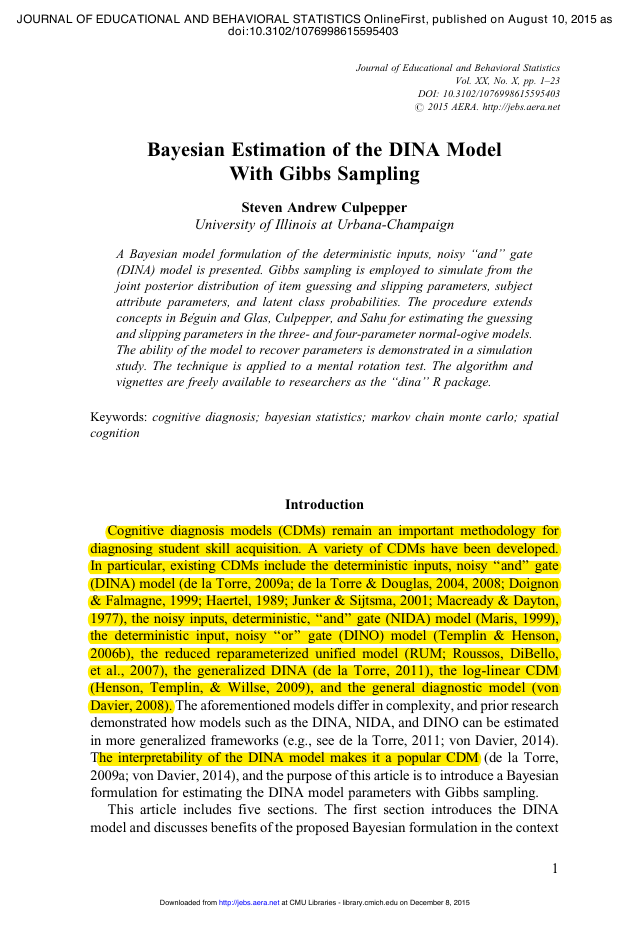
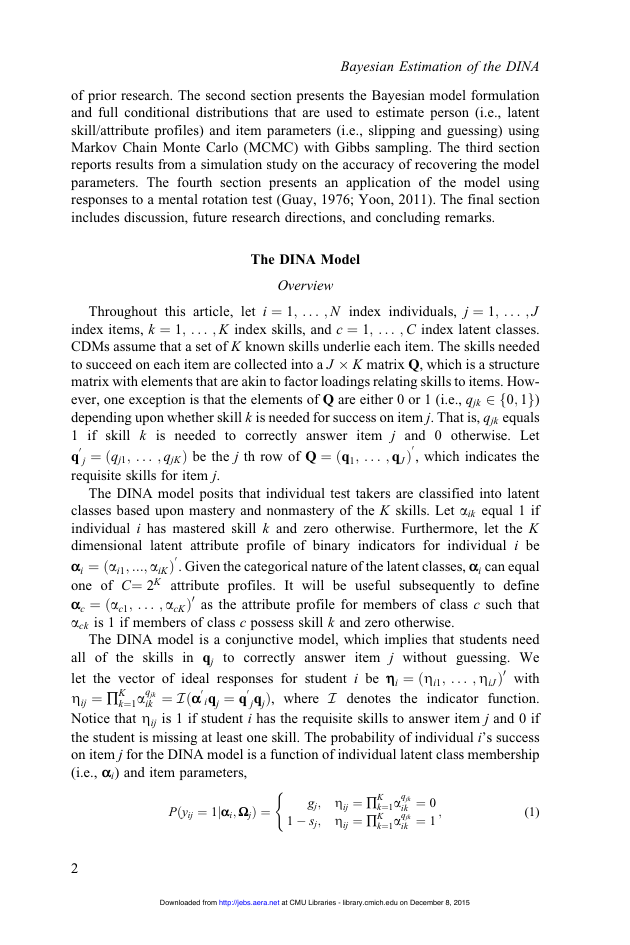
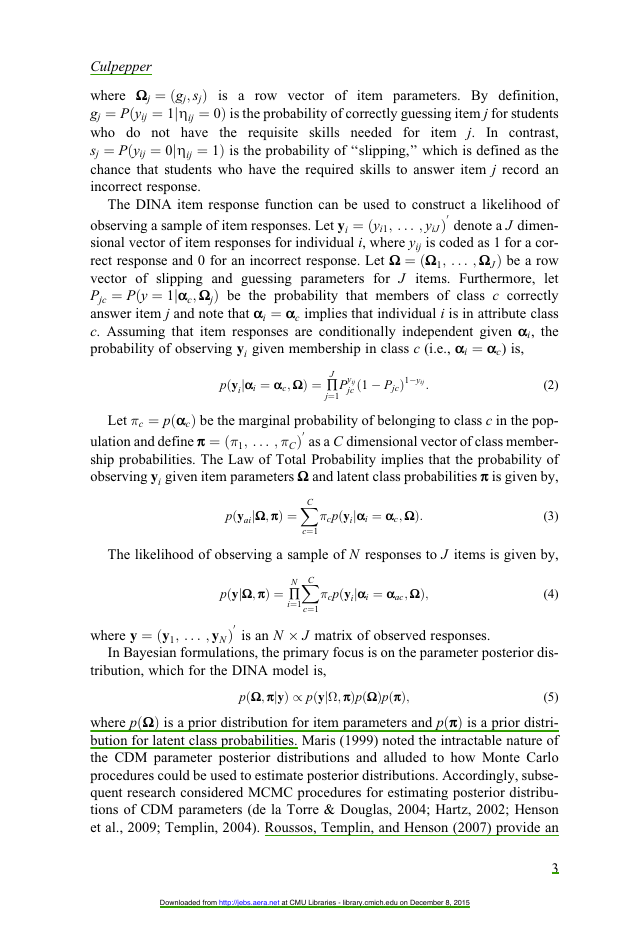
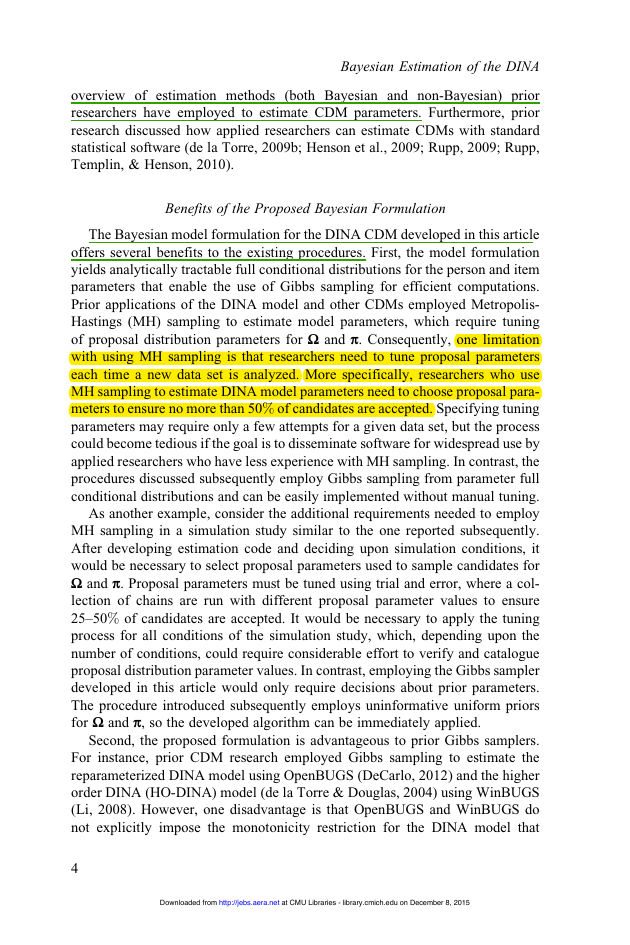
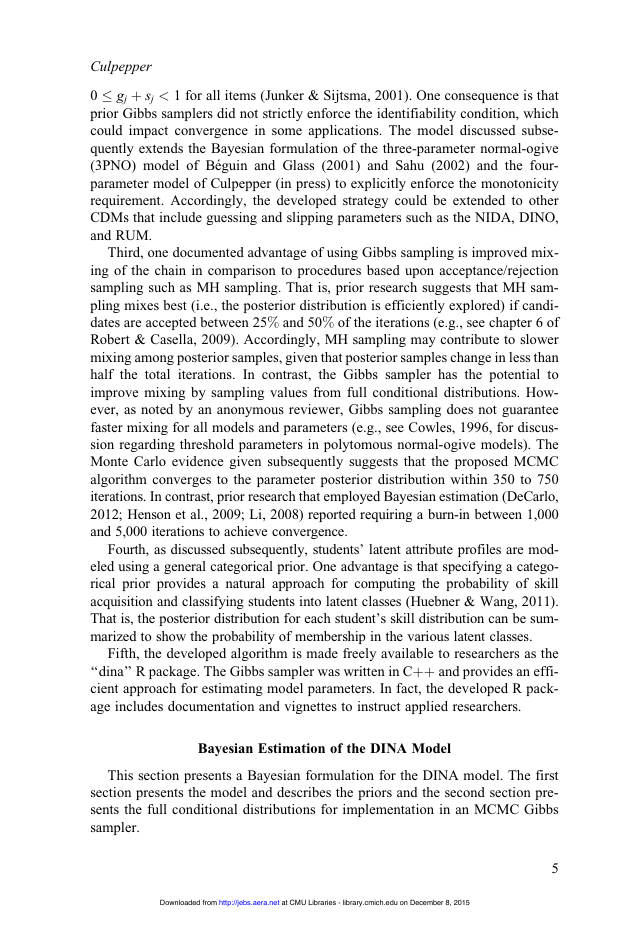
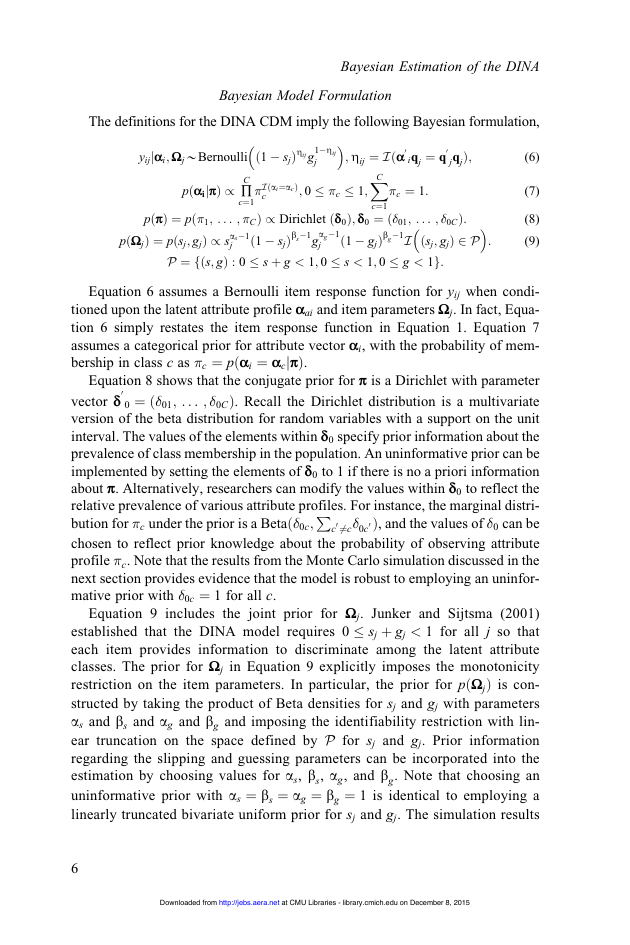

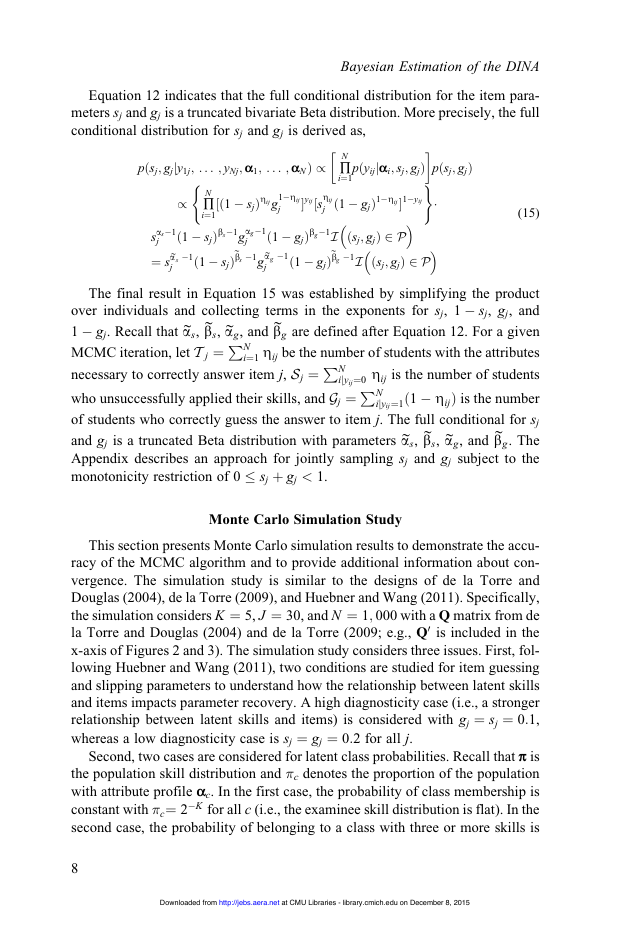








 2023年江西萍乡中考道德与法治真题及答案.doc
2023年江西萍乡中考道德与法治真题及答案.doc 2012年重庆南川中考生物真题及答案.doc
2012年重庆南川中考生物真题及答案.doc 2013年江西师范大学地理学综合及文艺理论基础考研真题.doc
2013年江西师范大学地理学综合及文艺理论基础考研真题.doc 2020年四川甘孜小升初语文真题及答案I卷.doc
2020年四川甘孜小升初语文真题及答案I卷.doc 2020年注册岩土工程师专业基础考试真题及答案.doc
2020年注册岩土工程师专业基础考试真题及答案.doc 2023-2024学年福建省厦门市九年级上学期数学月考试题及答案.doc
2023-2024学年福建省厦门市九年级上学期数学月考试题及答案.doc 2021-2022学年辽宁省沈阳市大东区九年级上学期语文期末试题及答案.doc
2021-2022学年辽宁省沈阳市大东区九年级上学期语文期末试题及答案.doc 2022-2023学年北京东城区初三第一学期物理期末试卷及答案.doc
2022-2023学年北京东城区初三第一学期物理期末试卷及答案.doc 2018上半年江西教师资格初中地理学科知识与教学能力真题及答案.doc
2018上半年江西教师资格初中地理学科知识与教学能力真题及答案.doc 2012年河北国家公务员申论考试真题及答案-省级.doc
2012年河北国家公务员申论考试真题及答案-省级.doc 2020-2021学年江苏省扬州市江都区邵樊片九年级上学期数学第一次质量检测试题及答案.doc
2020-2021学年江苏省扬州市江都区邵樊片九年级上学期数学第一次质量检测试题及答案.doc 2022下半年黑龙江教师资格证中学综合素质真题及答案.doc
2022下半年黑龙江教师资格证中学综合素质真题及答案.doc